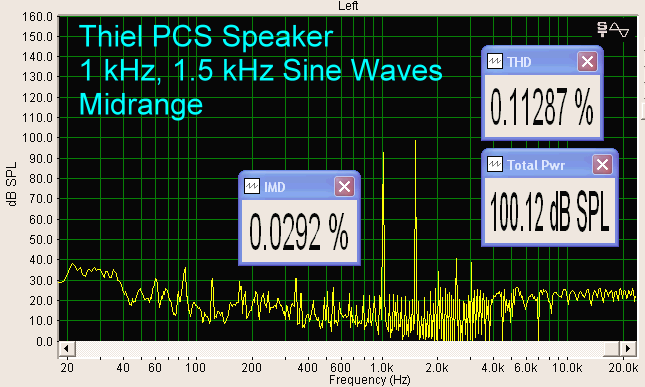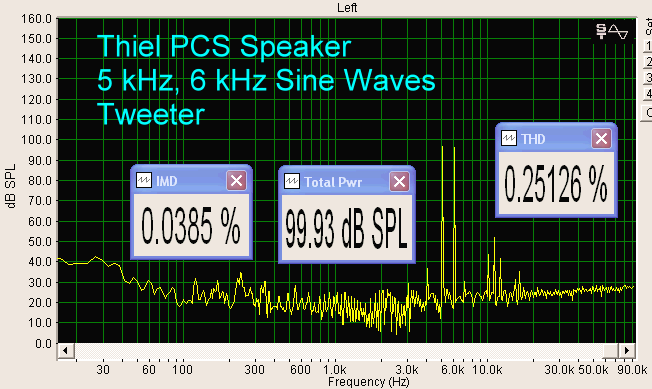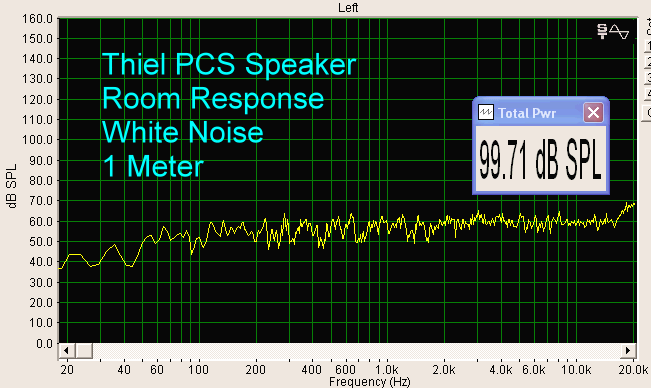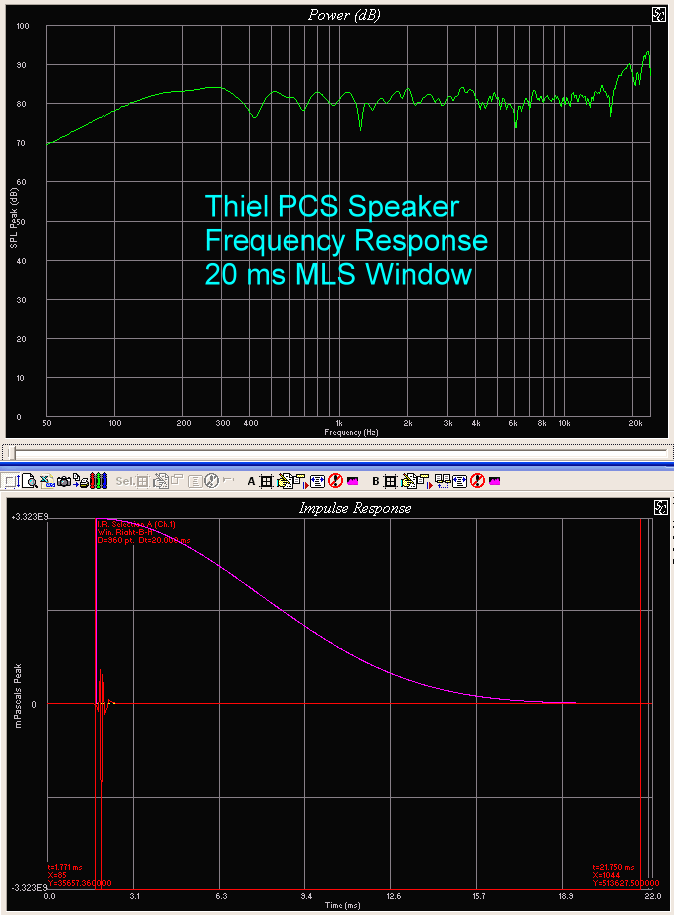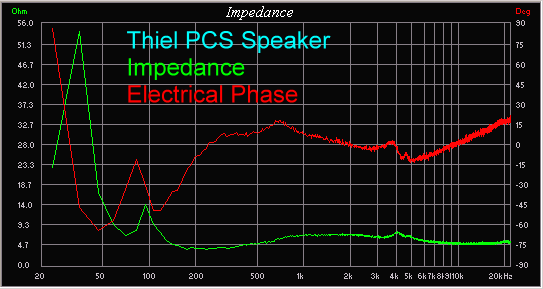|
|||||||||
|
Introduction The PCS is part of Thiel's bookshelf line of speakers, which includes the SCS3 and MCS1. The Design Like the CS2.4, the PCS has a 1" metal dome tweeter and 3.5" metal midrange driver that are configured coaxially, meaning the tweeter sits in the center of the midrange driver. The center 1" is the tweeter, with a small black rubber surround, then the midrange driver, and its surround. The tweeter and midrange share the same voice coil. The crossover between the midrange and tweeter is mechanical (they are mechanically coupled), at 3 kHz, and this would have the same phase and amplitude as 2nd order electrical crossovers. There will be at least a capacitor before the tweeter/mid to prevent low frequencies from reaching it. The coaxial design of the tweeter/mid will prevent lobing between the two drivers. The 6.5" woofer is situated below the tweeter/mid driver, and the port is below the woofer on the front of the enclosure. Crossover from the woofer to the tweeter/mid is electrical 1st order at 800 Hz.
The rear of the enclosure has a single pair of heavy gold
plated speaker binding posts that will accept large spades and banana plugs. The enclosures can be purchased in several wood veneers. The review units were in Amberwood, which is one of my favorite finishes (it looks like Rosewood). My favorite veneer is Cherry, which is also available from Thiel. (My favorite exotic woods are Jarrah and Bubinga, which are rare and not generally available.) A rap on the enclosures is reassuringly solid, with very little resonance. The front baffle is 2" thick, while the main enclosure is 1" thick. Heavy internal bracing is also employed. The front baffle is at an angle, with the tweeter somewhat back from the woofer. This is what Thiel calls "Coherent Source", and PCS stands for Personal Coherent Source. It basically means that the drivers are time aligned so that the signal from the tweeter and woofer arrive at your ears coincidentally (at the same time). The edges of the front baffle are rounded so as to minimize edge diffraction. The Listening I tested the PCS with a Classé SACD-2 player, Balanced Audio Technology VK-5i preamplifier, McIntosh MC-602 power amplifier, and Nordost cables. The PCS sound quite forward in the high frequencies, and this is confirmed in the frequency response tests. Detail was excellent as a result, without being harsh, which my aging ears really appreciate. Usually, if a speaker is high frequency forward, it can sound "bright" which is often unpleasant. Not so with the PCS. My McIntosh MC-602 can dish out 600 watts rms per channel without flinching, and the PCS took all that was delivered without sounding mushy at high volume. They are not very sensitive though, so you will need plenty of power to show off their capabilities. I toed the PCS in at about 100, which gave me a terrific soundstage and no hole in the middle. Off-axis sound was excellent too. The PCS sound much bigger than they are physically (the soundstage is huge). This is a result in part from the time alignment and the coaxial tweeter and midrange driver configuration. Diffraction effects are minimized. Using SACDs with speakers that have such fine detail is an ideal showcase for both products, but conventional CDs also shone on the PCS.
My current "hot" SACD album is Brain, with Hiromi
on jazz piano (Telarc SACD-63600). It is electronic music to a large extent,
and the transients will display a speaker's ability to reproduce detail to a
high degree,
Voices, such as Tony Bennett, sounded very natural on the PCS. There was no boominess, no chestiness, and no sibilance. The increased frequency response of the PCS above 18 kHz (see On the Bench, below) does not affect the human voice (too much sibilance is a result of peaks around 6 kHz). Although the PCS are powerful speakers, they are a bit weak in the bass for my tastes (I really love deep bass). So, for those of you with similar slants, I would recommend the use of a good subwoofer. We had on hand the new Thiel SS2 subwoofer and Subwoofer Integrator, which were fantastic additions to the PCS. I will report on those products in later reviews. Recordings where the addition of the subwoofer really made a difference included Stravinsky's The Firebird (Telarc SACD-60039) and Tchaikovsky's 1812 Overture (Telarc SACD-60541). On the Bench For THD measurements, the microphone was placed 6.5" from the corresponding driver. Frequency response measurements were made at 1 meter distance from the center of the speaker, on axis. The PCS are rated down to 55 Hz. Using a 50 Hz sine wave input signal, THD+N was very high, showing that the PCS are not meant for sounds below that 55 Hz rating. It indicates to me that a subwoofer should be used, with the low-pass set to perhaps 60 Hz for best results (high-pass at 60 Hz and above to the PCS, low-pass below 60 Hz to the subwoofer).
At 75 Hz, the story was much different. Well within the PCS' range, there was a remarkably low 0.5% THD+N at 100 dB.
At 100 Hz, THD+N was lower yet. This relatively small woofer is an excellent performer. One of the best I have seen.
Moving on to the tweeter/midrange driver, a 1 kHz sine wave produced 0.7% THD+N. At this frequency, the sound is coming from the midrange driver.
IMD was a low 0.03%, using 1 kHz and 1.5 kHz signals.
IMD from the tweeter, using 5 kHz and 6 kHz sine waves, was only 0.04%.
At 10 kHz, THD+N was a very manageable 0.3%.
Again, IMD was very low when inputting 10 kHz and 11 kHz sine waves.
Using white noise to test the room response, you can see that the PCS had a very flat response, with a bit of an upswing above 18 kHz.
The quasi-anechoic frequency response was very flat between 100 Hz and 18 kHz, and the upswing in response above 18 kHz is confirmed from the room response.
Impedance tended to stay between 3 Ohms and 6 Ohms from 150 Hz to 20 kHz. Below 150 Hz, the impedance rose, with a maximum at about 40 Hz. The low impedance means you should not use these speakers with mass market receivers. Electrical phase was ± 150 between 200 Hz and 20 kHz. Phase varied beyond the 150 mark below 200 Hz.
Conclusions At $3,000 the pair, Thiel's new PCS monitor speakers are an excellent value. They are built to complement any fine room decor, and will please the ears of the most demanding audio aficionado.
|
|||||||||

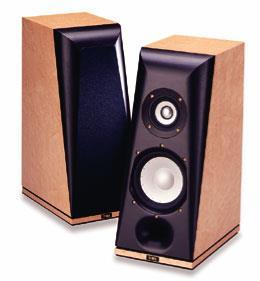

 which is exactly what the PCS did with this recording.
which is exactly what the PCS did with this recording.



